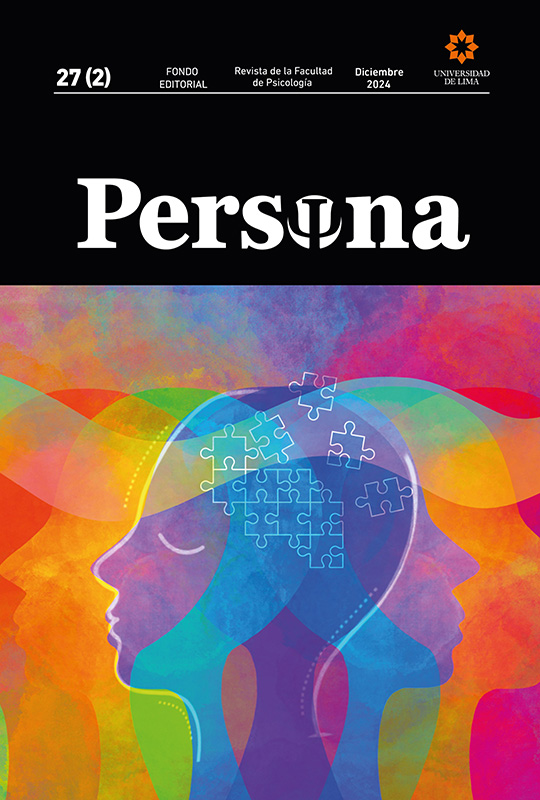Síntomas de ansiedad y de depresión en distintas etapas vitales
DOI:
https://doi.org/10.26439/persona2024.n27(2).7324Palabras clave:
síntomas, ansiedad, depresión, riesgo, edadResumen
Los síntomas de ansiedad y de depresión representan un problema para los sistemas de salud. Distintas variables sociodemográficas inciden sobre el riesgo de padecerlas, y entre ellas se halla la etapa vital. Dado que la literatura investigativa no es clara respecto de cuáles son los grupos etarios de riesgo, la presente investigación se propuso evaluar la sintomatología de ansiedad y de depresión en distintos grupos etarios (18 a 24 años, 25 a 55 años y 56 a 65 años) de adultos de la Ciudad Autónoma de Buenos Aires - CABA (35 %) y del Conurbano Bonaerense (65 %), considerando las interacciones con el género y el nivel de instrucción. Se administraron un cuestionario sociodemográfico, el inventario de ansiedad de Beck y el inventario de depresión de Beck. Los resultados muestran que el grupo de 18 a 24 años reportó niveles más elevados de síntomas de ansiedad que los otros. El grupo de 25 a 55 años informó mayores niveles de síntomas depresivos que el grupo de 56 a 65 años. Con respecto al género, las mujeres reportaron niveles más elevados de ansiedad y de depresión. En cuanto a la interacción entre las variables, las personas de género femenino de 25 a 55 años reportaron niveles más elevados de síntomas de ansiedad que los masculinos de la misma edad. Con respecto al nivel de instrucción, se hallaron diferencias entre grupos, pero la interacción con la variable grupos etarios no resultó significativa. Estos resultados permiten una mayor comprensión del fenómeno y resaltan la importancia del abordaje de grupos de riesgo.
Descargas
Referencias
Agbangba, C. E., Aide, E. S., Honfo, H., & Kakai, R. G. (2024). On the use of post-hoc tests in environmental and biological sciences: A critical review. Heliyon, 10(3), Artículo e25131. https://doi.org/10.1016/j.heliyon.2024.e25131
Altieri, M., Trojano, L., Gallo, A., & Santangelo, G. (2020). The relationships between cognitive reserve and psychological symptoms: A cross-sectional study in healthy individuals. The American Journal of Geriatric Psychiatry, 28(4), 404–409. https://doi.org/10.1016/j.jagp.2019.07.017
American Psychological Association. (2010). Ethical principles of psychologists and code of conduct. http://www.apa.org/ethics/code/principles.pdf
Arias de la Torre, J., Vilagut, G., Martín, V., Molina, A. J., & Alonso, J. (2018). Prevalence of major depressive disorder and association with personal and socio-economic factors. Results for Spain of the European Health Interview Survey 2014–2015. Journal of Affective Disorders, 239, 203–207. https://doi.org/10.1016/j.jad.2018.06.051
Arias de la Torre, J., Vilagut, G., Ronaldson, A., Dregan, A., Ricci-Cabello, I., Hatch, S. L., Serrano-Blanco, A., Valderas, J. M., Hotopf, M., & Alonso, J. (2021). Prevalence and age patterns of depression in the United Kingdom. A population-based study. Journal of Affective Disorders, 279, 164–172. https://doi.org/10.1016/j.jad.2020.09.129
Balsamo, M., Cataldi, F., Carlucci, L., & Fairfield, B. (2018). Assessment of anxiety in older adults: A review of self-report measures. Clinical Interventions in Aging, 13, 573–593. https://doi.org/10.2147/CIA.S114100
Beck, A. T., Epstein, N., Brown, G., & Steer, R. A. (1988). An inventory for measuring clinical anxiety: Psychometric properties. Journal of Consulting and Clinical Psychology, 56(6), 893-897. https://doi.org/10.1037/0022-006X.56.6.893
Beck, A. T., Steer, R. A., & Brown, G. K. (2006). Inventario de Depresión de Beck (BDI-II), Manual. Paidós.
Brenlla, M. E., & Rodríguez, C. M. (2006). Adaptación argentina del Inventario de Depresión de Beck (BDI-II). Paidós.
Carlucci, L., Watkins, M. W., Sergi, M. R., Cataldi, F., Saggino, A., & Balsamo, M. (2018). Dimensions of anxiety, age, and gender: Assessing dimensionality and measurement invariance of the StateTrait for Cognitive and Somatic Anxiety (STICSA) in an Italian sample. Frontiers in Psychology, 9, Artículo 2345. https://doi.org/10.3389/fpsyg.2018.02345
Cía, A. H., Stagnaro, J. C., Aguilar Gaxiola, S., Vommaro, H., Loera, G., Medina-Mora, M. E., Sustas, S., Benjet, C., & Kessler, R. C. (2018). Lifetime prevalence and age-of-onset of mental disorders in adults from the Argentinean Study of Mental Health Epidemiology. Social Psychiatry and Psychiatric Epidemiology, 53(4), 341–350. https://doi.org/10.1007/s00127-018-1492-3
Cohen, J. (1988). Statistical Power Analysis for the Behavioral Sciences. Lawrence Erlbaum Associates.
Cuijpers, P., Karyotaki, E., Eckshtain, D., Ng, M. Y., Corteselli, K. A., Noma, H., Quero, S., & Weisz, J. R. (2020). Psychotherapy for depression across different age groups: A systematic review and meta-analysis. JAMA Psychiatry, 77(7), 694–702. https://doi.org/10.1001/jamapsychiatry.2020.0164
Dattani, S., Rodés-Guirao, L., Ritchie, H. & Roser, M. (2023). Mental Health. Our World in Data. https://ourworldindata.org/mental-health
Doran, C. M., & Kinchin, I. (2017). A review of the economic impact of mental illness. Australian Health Review, 43(1), 43-48. https://doi.org/10.1071/AH16115
Etchevers, M. J., Garay, C. J., Putrino, N., Grasso, J., Helmich, N. & Rojas, L. (2021a). Relevamiento del estado psicológico de la población argentina. Observatorio de Psicología Social Aplicada, Facultad de Psicología, Universidad de Buenos Aires. http://www.psi.uba.ar/opsa/#informes
Etchevers, M. J., Garay, C. J., Putrino, N. I., Helmich, N., & Lunansky, G. (2021b). Argentinian mental health during the COVID-19 pandemic: a screening study of the general population during two periods of quarantine. Clinical Psychology in Europe, 3(1), 1-17. https://doi.org/10.32872/cpe.4519
Fernández, R. S., Crivelli, L., Guimet, N. M., Allegri, R. F., & Pedreira, M. E. (2020). Psychological distress associated with COVID-19 quarantine: Latent profile analysis, outcome prediction and mediation analysis. Journal of Affective Disorders, 277, 75–84. https://doi.org/10.1016/j.jad.2020.07.133
Fernández, R. S., Crivelli, L., Guimet, N. M., Allegri, R. F., Picco, S., & Pedreira, M. E. (2022). Psychological distress and mental health trajectories during the COVID-19 pandemic in Argentina: a longitudinal study. Scientific Reports, 12(1), Artículo 5632. https://doi.org/10.1038/s41598-022-09663-2
Games, P. A., & Howell, J. F. (1976). Pairwise multiple comparison procedures with unequal N’s and/or variances: A Monte Carlo study. Journal of Educational Statistics, 1(2), 113–125. https://doi.org/10.2307/1164979
Gao, W., Ping, S., & Liu, X. (2020). Gender differences in depression, anxiety, and stress among college students: a longitudinal study from China. Journal of Affective Disorders, 263, 292-300. https://doi.org/10.1016/j.jad.2019.11.121
Grenier, S., Payette, M.-C., Gunther, B., Askari, S., Desjardins, F. F., Raymond, B., & Berbiche, D. (2019). Association of age and gender with anxiety disorders in older adults: A systematic review and meta-analysis. International Journal of Geriatric Psychiatry, 34(3), 397–407. https://doi.org/10.1002/gps.5035
Hernández-Sampieri, R., & Mendoza, C. (2018). Metodología de la investigación, las rutas cuantitativa, cualitativa y mixta. Mc Graw Hill.
Kessler, R. C., Birnbaum, H., Bromet, E., Hwang, I., Sampson, N., & Shahly, V. (2010). Age differences in major depression: results from the National Comorbidity Survey Replication (NCS-R). Psychological Medicine, 40(2), 225–237. https://doi.org/10.1017/S0033291709990213
Khesht-Masjedi, M. F., Shokrgozar, S., Abdollahi, E., Habibi, B., Asghari, T., Ofoghi, R. S., & Pazhooman, S. (2019). The relationship between gender, age, anxiety, depression, and academic achievement among teenagers. Journal of Family Medicine and Primary Care, 8(3), 799–804. https://doi.org/10.4103/jfmpc.jfmpc_103_18
Kohn, R., Ali, A. A., Puac-Polanco, V., Figueroa, C., López-Soto, V., Morgan, K., Saldivia, S., & Vicente, B. (2018). Mental health in the Americas: an overview of the treatment gap. Revista Panamericana de Salud Pública, 42, Artículo e165. https://doi.org/10.26633/RPSP.2018.165
Kohr, R. L., & Games, P. A. (1974). Robustness of the analysis of variance, the Welch procedure and a box procedure to heterogeneous variances. Journal of Experimental Education, 43(1), 61–69. https://doi.org/10.1080/00220973.1974.10806305
Layous, K., Chancellor, J., & Lyubomirsky, S. (2014). Positive activities as protective factors against mental health conditions. Journal of Abnormal Psychology, 123(1), 3–12. https://doi.org/10.1037/a0034709
Mazza, C., Ricci, E., Biondi, S., Colasanti, M., Ferracuti, S., Napoli, C., & Roma, P. (2020). A nationwide survey of psychological distress among Italian people during the COVID-19 pandemic: Immediate psychological responses and associated factors. International Journal of Environmental Research and Public Health, 17(9), Artículo 3165. https://doi.org/10.3390/ijerph17093165
Mommersteeg, P. M., van Valkengoed, I., Lodder, P., Juster, R. P., & Kupper, N. (2024). Gender roles and gender norms associated with psychological distress in women and men among the Dutch general population. Journal of Health Psychology, 29(8), 797-810. https://doi.org/10.1177/13591053231207294
Otzen, T., & Manterola, C. (2017). Técnicas de muestreo sobre una población a estudio. International Journal of Morphology, 35(1), 227-232. https://doi.org/10.4067/S0717-95022017000100037
Pagano, A. E., & Vizioli, N. A. (2021). Estabilidad temporal y validez discriminante del Inventario de Ansiedad de Beck. Liberabit, Revista Peruana de Psicología, 27(1), artículo e450. http://dx.doi.org/10.24265/liberabit.2021.v27n1.03
Patel, V., Burns, J. K., Dhingra, M., Tarver, L., Kohrt, B. A., & Lund, C. (2018). Income inequality and depression: a systematic review and meta-analysis of the association and a scoping review of mechanisms. World Psychiatry: Official Journal of the World Psychiatric Association (WPA), 17(1), 76-89. https://doi.org/10.1002/wps.20492
Ruiz-Rodríguez, P., Cano-Vindel, A., Muñoz, R., Medrano, L., Moriana, J. A., Buiza, C., Jiménez, G., Gonzáles Blanch, C., & Grupo de Investigación PsicAP. (2017). Impacto económico y carga de los trastornos mentales comunes en España: una revisión sistemática y crítica. Ansiedad y Estrés, 23(2-3), 118-123. https://doi.org/10.1016/j.anyes.2017.10.003
Solomou, I., & Constantinidou, F. (2020). Prevalence and Predictors of Anxiety and Depression Symptoms during the COVID-19 Pandemic and compliance with precautionary measures: Age and sex matter. International Journal of Environmental Research and Public Health, 17(14), Artículo 4924. https://doi.org/10.3390/ijerph17144924
Sauder, D. C., & DeMars, C. E. (2019). An updated recommendation for multiple comparisons. Advances in Methods and Practices in Psychological Science, 2(1), 26–44. https://doi.org/10.1177/2515245918808784
Tian, F., Li, H., Tian, S., Yang, J., Shao, J., & Tian, C. (2020). Psychological symptoms of ordinary Chinese citizens based on SCL-90 during the level I emergency response to COVID-19. Psychiatry Research, 288, Artículo 112992. https://doi.org/10.1016/j.psychres.2020.112992
Vizioli, N. A. (2024). Beck Anxiety Inventory: Measurement invariance, latent mean comparison, and reliability in adults from Buenos Aires. Psychological Thought, 17(1), 35-57. https://doi.org/10.37708/psyct.v17i1.792
Vizioli, N., & Crespi, M. C. (2020). Factores estresantes y sintomatología psicológica durante el aislamiento social preventivo obligatorio por COVID-19 en población adulta de Buenos Aires. Subjetividad y Procesos Cognitivos, 24(2), 17-41. https://dspace.uces.edu.ar/jspui/bitstream/123456789/5704/1/Vizioli_otros_Factores_Estresantes_Sintomatologia.pdf
Vizioli, N. A., & Pagano, A. E. (2020). Adaptación del Inventario de Ansiedad de Beck en población de Buenos Aires. Interacciones, Journal of Family, Clinical and Health Psychology, 6(3), Artículo e171. https://doi.org/10.24016/2020.v6n3.171
Vizioli, N. A., & Pagano, A. E. (2022). Inventario de Ansiedad de Beck: validez estructural y fiabilidad a través de distintos métodos de estimación en población argentina. Acta Colombiana de Psicología, 25(1), 28-41. https://doi.org/10.14718/acp.2022.25.1.3
Welch, B. L. (1938). The significance of the difference between two means when the population variances are unequal. Biometrika, 29(3/4), 350-362. https://doi.org/10.2307/2332010
World Medical Association. (2013). Declaration of Helsinki. Ethical principles for medical research involving human subjects. JAMA Network, 310(20), 2191-2194. https://doi.org/10.1001/jama.2013.281053
Zuckerman, M. (1999). Vulnerability to psychopathology: A biosocial model. American Psychological Association. https://doi.org/10.1037/10316-000
Publicado
Número
Sección
Licencia
La aceptación de publicación implica ceder los derechos de impresión y de reproducción por cualquier forma y medio al editor, manteniendo el autor la propiedad intelectual del artículo.











